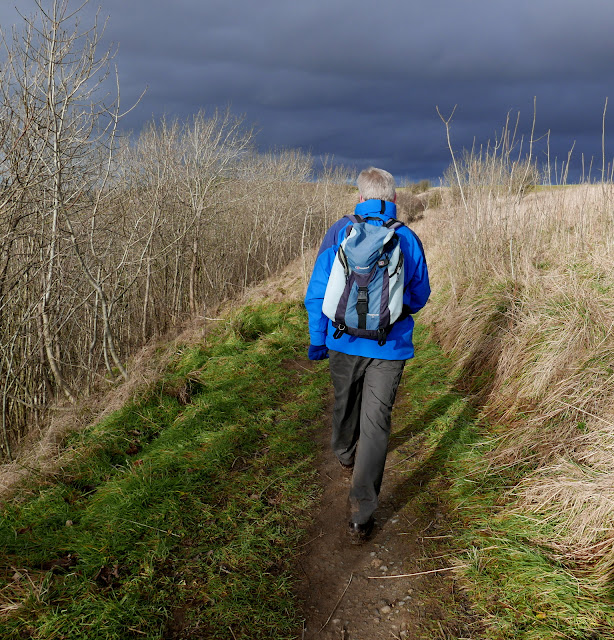Boltby to Gormire Lake and Whitestone Cliff
7 miles Cold and bright
We thought we would return to Gormire where we recently saw a Golden Pheasant, but on this walk approaching the lake from the opposite direction, Boltby.
We reached Boltby from the A19 Knayton turn off and drove right through the village and up a steep hill to a small designated car park at the side of the road.
We walked back down the road into Boltby where we took the first left into a lane. Tom Scott Burns explains that Boltby is of great antiquity and is mentioned in the Domesday Book as the property of Hugh, son of Baldric.
 |
| Today's walk from The Walker's Guide to the Hambleton Hills |
 |
| The Old School House in Boltby |
 |
| We turn left at the junction |
 |
| Weather vanes in Boltby |
We passed the last of the houses and soon our lane petered out and we went through a gate to follow a faint track over the shoulder of Little Moor, from where we were able to look down on Greendale Farm.
 |
| The lane ends at a ford and we cross the bridge... |
 |
| ... through the mud to Little Moor |
 |
| Horse riders have made the footpath difficult as we approach Cow Pasture Wood |
 |
| Follow the sign to Tang Hall |
 |
| Looking down on Greendale Farm |
We dropped down to Greendale Farm and continued around the side of a hill to reach Tang Hall Farm where we turned left just before the buildings.
 |
| Turn left to walk past Tang Hall Farm |
 |
| A mixed flock at Tang Hall |
We were now walking on the old coach road across Huggon Howl to Southwoods Hall, although it is now just a grassy path.
Reaching the gates of Southwoods Hall we turned onto a forest track into South Woods, which we followed to reach Southwoods Lodge.
 |
| Huggon Howl and Southwoods Hall |
 |
| Large lake in front of Southwoods Hall |
 |
| We pass by the closed gates to the Hall |
 |
| Southwoods Lodge |
On reaching the lodge we followed the track straight ahead through Garbutt Wood, eventually reaching Gormire Lake. Despite walking quietly and looking carefully, we saw no sign of last walk's golden pheasant. We walked round the lake to find a sheltered spot and sat watching a heron work his way along the far bank while we enjoyed our coffee and scones.
 |
| We take the track straight on from Southwoods Lodge |
 |
| Gormire Lake appears ahead |
 |
| A good spot for coffee |
 |
| A heron on the far bank |
There are two terraces around Gormire and TSB explains that these were once shorelines when the lake was much deeper. Its is often described as bottomless but is actually about 27 feet deep in the centre and covers about twenty six acres. Tradition has it that a town stood here which was destroyed in an earthquake, but the lake is actually the result of a glacial overflow channel being blocked by a landslip, hence its position up a hillside. No streams flow from it and its waters are mainly supplied by rain and diminish with evaporation. A major landslip happened here on the 25th March 1755 which was described by Rev John Wesley as 'like many cannons or rolling thunder'.
Leaving the lake we climbed straight up through Garbutt Wood to reach Sutton Brow. This is a steep half mile diagonally up the side of the bank and we were much warmer by the time we reached the top.
From here there is a fine view back to Gormire Lake and to the left over towards Roulston Scar. After catching our breath we set off past Whitestone Cliff, still looking down at the lake from various vantage points.
 |
| A steep climb |
 |
| Looking over to Hood Hill |
 |
| We reach the top and walk alongside the gallops |
 |
| Gormire now far below |
 |
| A couple of walkers enjoy the view even though they don't appear to have scones |
 |
| Now looking back from Whitestone Cliff |
We now had a three mile walk along the ridge, passing the remains of several tumuli to our right and with fine views to our left over Boltby.
Eventually we passed by the remains of an old hill fort and quarry and reached the derelict High Barn where we left the ridge at a sign, turning left to descend towards Boltby.
























































































